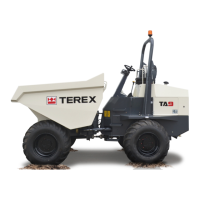Maintenance
TA9 & TA10 Dumper 0803-3 December 2010 9-28
Long Term Storage
If the machine is to be stored for a long period of time the
following procedures must be applied:-
• Thoroughly wash down the exterior of the machine and
remove any build up of dirt etc.
• Repair all damaged paint work to prevent further corrosion.
• Grease all greasing points.
• Start and warm up the engine. Drain the engine oil and refill
with clean fresh oil. Refer to engine manufacturers
handbook for further information on prolonged engine
storage with regards to anti-corrosion oils and fluids.
• Check hydraulic oil level and top up as required.
• Drain, and refill cooling system with water/antifreeze
mixture (see Specifications section).
• Store the machine on solid level ground which is not liable
to flooding, standing water or airborne contamination.
• Chock the wheels securely to prevent the dumper moving.
• Smear exposed metal parts with grease.
• Remove the battery and keep fully charged.
• Leave the parking brake in the OFF position.
Scrapping the Machine
The appropriate lifting equipment, chocks and stands must be
used to maintain a stable machine as components are removed
and the machines centre of mass changes.
Care must be taken when dealing with flammable liquids and
the machine parts that contained those liquids. Any process that
could ignite flammable materials must not be used on
components that have contained flammable liquids in them or
have residual flammable liquids on them.
Fire extinguishers must be readily available if cutting/welding
equipment is to be used.
Fluids must be drained off into suitable containers and if
possible recycled or otherwise disposed of in an
environmentally friendly way in accordance with local
regulations.
Where possible recyclable materials should be separated out
and processed in accordance with local regulations using an
authorised agent.
b
Contaminated Water / Fluids / Oils Must Be Disposed of
Legally
b
At the end of its life the machine should be
disassembled by a competent person using safe
working practices, wearing the appropriate Personal
Protective Equipment and working in accordance with
local regulations.

